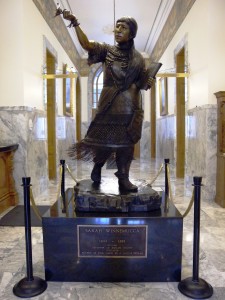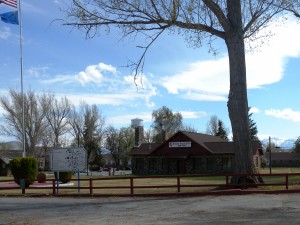» posted on Monday, April 23rd, 2012 by Linda Lou Burton
In Ink and Stone
 Linda Burton posting from Carson City, Nevada — A statue of Sarah Winnemucca graces the center spot of the Nevada State Capitol; a copy representing Nevada stands in Statuary Hall in the US Capitol in Washington, DC. Notice the book Sarah holds in her hand. It is a telling emblem of the life of one of the most influential American Indian women in American history. Born into a legendary Paiute family in 1844, Sarah lived when the influx of white settlers began. Spending time with white families in the 1850’s, she learned the ways of the white world and mastered the English language. In the 1860’s she became an interpreter for the US Army; in the 1870’s she served the Army as a scout. So what about the book?
Linda Burton posting from Carson City, Nevada — A statue of Sarah Winnemucca graces the center spot of the Nevada State Capitol; a copy representing Nevada stands in Statuary Hall in the US Capitol in Washington, DC. Notice the book Sarah holds in her hand. It is a telling emblem of the life of one of the most influential American Indian women in American history. Born into a legendary Paiute family in 1844, Sarah lived when the influx of white settlers began. Spending time with white families in the 1850’s, she learned the ways of the white world and mastered the English language. In the 1860’s she became an interpreter for the US Army; in the 1870’s she served the Army as a scout. So what about the book?
When Paiutes were exiled from Nevada after the Bannock War of 1878, Sarah Winnemucca spent her next years fighting for their return. She testified before Congress. She met with President Rutherford B Hayes and Secretary of the Interior Charles Schurz. She appealed to public opinion on both coasts through lectures, interviews, and newspaper statements, severely criticizing the reservation system. And in 1883, she wrote her autobiography, Life Among the Piutes: Their Wrongs and Claims.
The first book written by an American Indian woman, it combined the history and culture of the Paiute tribe with her own story.  Her friend and supporter Elizabeth Peabody of Boston had publishing expertise so got it into print; few books have lasted so well. Carefully analyzed by scholars and frequently cited by historians, it is once more in print today. But that’s not all Sarah did. In 1885 she started an American Indian school.
Her friend and supporter Elizabeth Peabody of Boston had publishing expertise so got it into print; few books have lasted so well. Carefully analyzed by scholars and frequently cited by historians, it is once more in print today. But that’s not all Sarah did. In 1885 she started an American Indian school.
The policy in the US at the time was to “civilize” the Indian; to eradicate Indian culture by “education for extinction” as it was described by some. Indian children were brought to non-reservation boarding schools far from their tribal culture to be assimilated; removed from their families to learn Euro-American ways. Sarah refused to allow federal boarding school officials to take her pupils without their parent’s consent, telling the press that children should be taught in their homeland in familiar surroundings, with parents nearby. Unfortunately Sarah’s school closed after four years due to lack of funding; she died in 1891.
http://www.amazon.com/Life-Among-Piutes-Wrongs-Claims/dp/0874172527
http://www.aoc.gov/cc/art/nsh/winnemucca.cfm
Non-reservation Indian Boarding Schools existed in the United States another hundred years, despite reports and recommendations criticizing their humanity and effectiveness. The Merriam Report of 1928 found the schools to be underfunded, understaffed, and run too rigidly. It recommended abolishing the Uniform Course of Study, which taught only Euro-American values, and having younger children attend community schools near home. Several events in the late 60’s and mid-70’s, such as the Kennedy Report and the National Study of American Indian Education, and the Indian Self-Determination and Education Assistance Act of 1975, led to renewed emphasis on community schools. Many large Indian boarding schools closed in the 1980’s.
 One of these was the Stewart Indian School in Carson City. It opened on December 17, 1890, with 37 students from Washoe, Paiute and Shoshone tribes, and closed in 1980 due to federal budget cuts. Thousands of students lived and studied here during that time; over the years the focus moved from vocational training to academics. You can walk among the ghostly memories today; there are over 60 native stone buildings.
One of these was the Stewart Indian School in Carson City. It opened on December 17, 1890, with 37 students from Washoe, Paiute and Shoshone tribes, and closed in 1980 due to federal budget cuts. Thousands of students lived and studied here during that time; over the years the focus moved from vocational training to academics. You can walk among the ghostly memories today; there are over 60 native stone buildings.  Dial the Talking Trail on your cell and listen to stories of the past. The former school is listed on the National Register of Historic Places. Memorabilia from there is displayed at the Nevada State Museum.
Dial the Talking Trail on your cell and listen to stories of the past. The former school is listed on the National Register of Historic Places. Memorabilia from there is displayed at the Nevada State Museum.
http://www.stewartindianschool.com/
